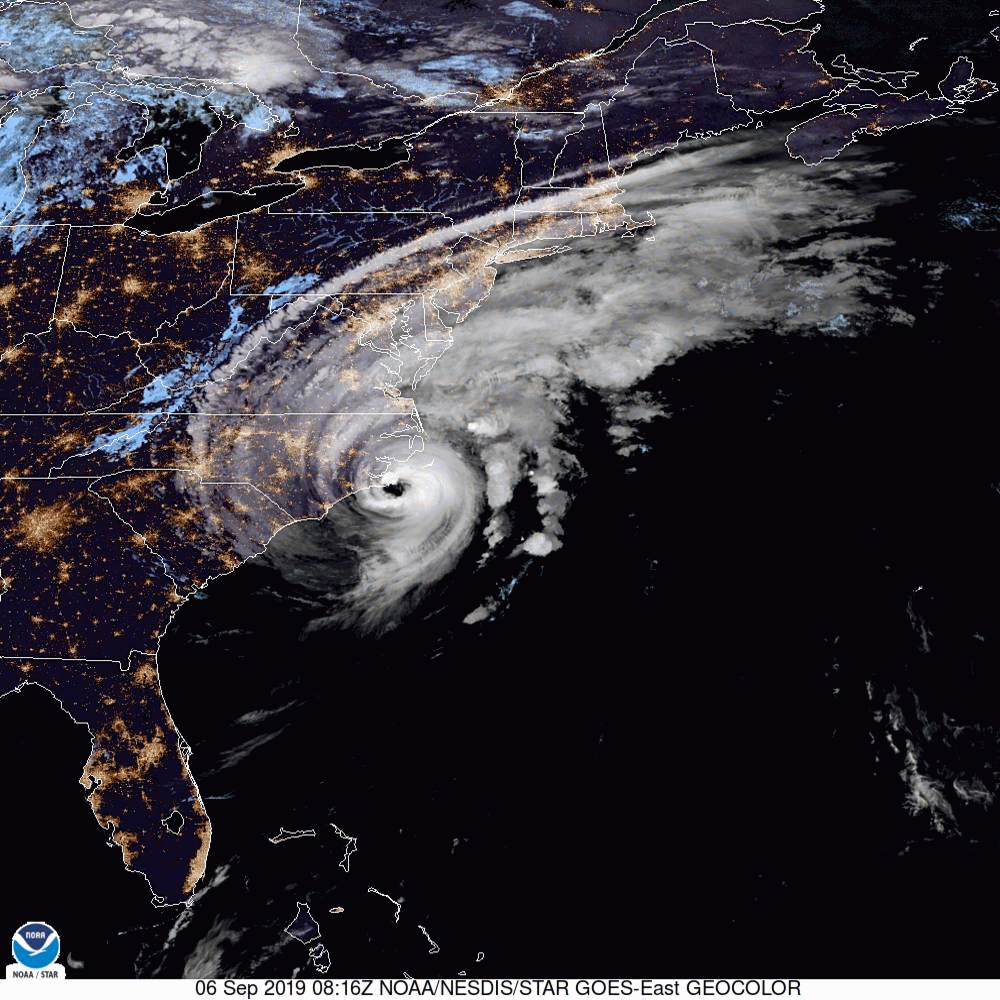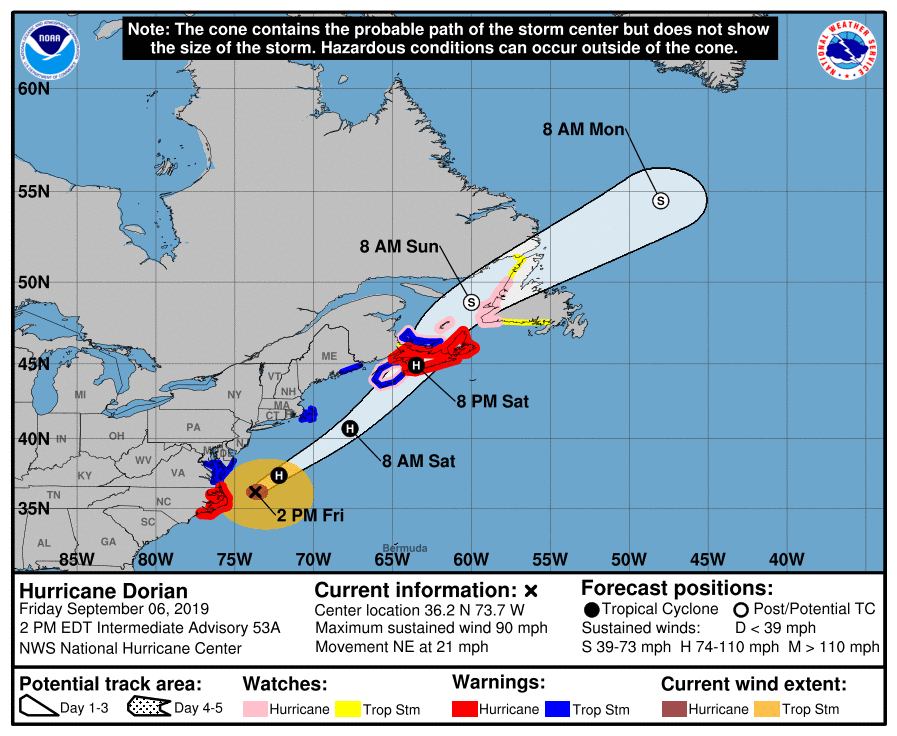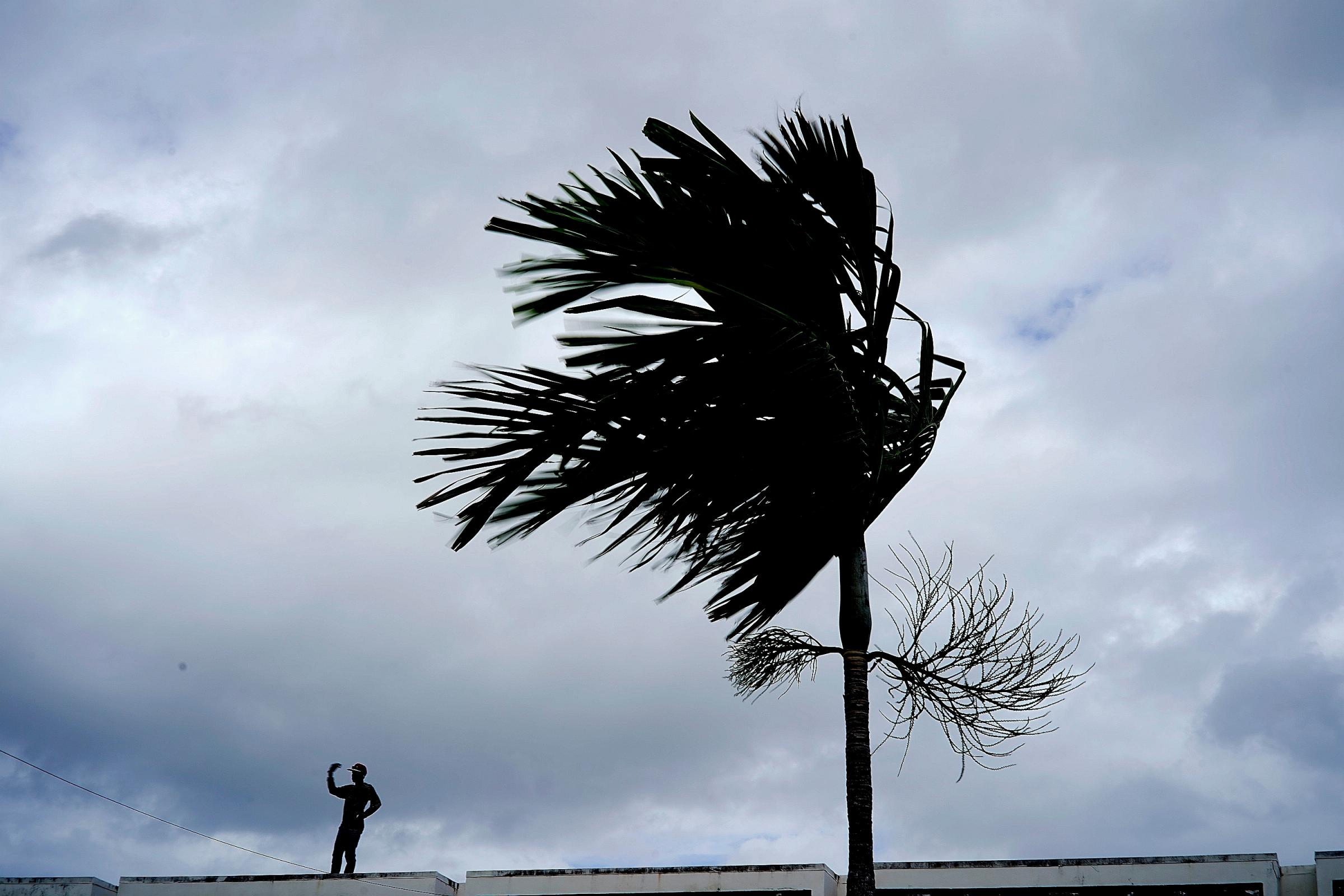Post-Tropical Cyclone Dorian continued into eastern Canada on Sunday with winds as high as 75 mph, following its Friday landfall in North Carolina that battered the state’s Outer Banks barrier islands.
As a hurricane, Dorian left the Bahamas devastated last week, with 60% of homes destroyed in some places and tens of thousands in need of urgent disaster relief, according to officials there. On Friday, the Bahamas’ Prime Minister Hubert Minnis said the death toll had increased to 43 and was likely to rise.
“We acknowledge that there are many missing and that the number of deaths is expected to significantly increase,” said Minnis, according to the Associated Press. “This is one of the stark realities we are facing in this hour of darkness.”
As of 2 p.m. ET Sunday, the eye of the storm was moving above the northeastern Gulf of St. Lawrence, approximately 40 miles east of Chevery, Quebec, according to the National Hurricane Center. The storm was moving northeast at 25 mph.
Dorian was downgraded to a Category 2 storm earlier this week after hitting the Bahamas as a record-breaking Category 5 on Sunday, Sept. 1.
Storm surges remain likely in the Gulf of St. Lawrence, the Southwest Coast of Newfoundland, and Eastern Nova Scotia and rainfall of one to two inches may stretch across “far eastern Quebec into Newfoundland and Labrador,” according to the National Hurricane Center’s latest update.
There are no longer warnings for Virginia, Maine, North Carolina and New England states.
“Finally, Hurricane Dorian has left North Carolina,” said the state’s Gov. Roy Cooper at a press conference late Friday afternoon. “We’re getting a look at the damage that it brought.”
In particular, Cooper noted the impact on Ocracoke Island, which was hit by storm surges. The island had no electricity and many homes and buildings are still underwater, Cooper said on Friday. 200 people remained in shelters on Saturday while 45,000 were without power, the Associated Press reports.
State officials have heard preliminary reports from residents about “catastrophic” flooding, saying “they’ve never seen it that bad” but said they have not received any reports yet about serious injuries or deaths caused by the storm.
One 79-year-old man, who needed immediate medical assistance for a condition unrelated to the storm, was airlifted by the coast guard, Cooper said.

The state’s emergency management agency had tweeted on Friday morning that the “threat of significant flash flooding” will continue even after Hurricane Dorian passes.
The storm was projected to bring up to 7 inches of rainfall in Nova Scotia.
Cooper had ordered a mandatory evacuation order for North Carolina’s coastal and barrier islands, effective Wednesday morning. He has since lifted evacuation orders for the barrier islands and southeastern parts of North Carolina but urged on Friday morning that residents “do not return home until your local officials say that it’s safe to do so.”
There were reports of up to 13 tornadoes in North Carolina Thursday but the threat of tornadoes has since “subsided,” said Katie Webster, a meteorologist with the state. There have been no reports of injuries from damage inflicted by tornadoes so far.
A tornado hit Emerald Isle, N.C. around 9 a.m. Thursday, resulting in wrecked and overturned buildings, according to the National Weather Service in Newport/Morehead City.
Another tornado hit Pender County earlier Thursday morning.
Just about a year ago, North Carolina faced another serious storm. Hurricane Florence made landfall as a Category 1 storm in Wrightsville Beach, N.C. last September and was eventually blamed for more than 50 deaths in the U.S.
Forecasters had said they did not expect Dorian to do as much damage. Florence was so devastating because of “the continued rainfall that pounded” the state, Edwards explains. “We do not expect (Dorian) to stall out over North Carolina,” he said. And it didn’t.

It has been a different story in the Bahamas. “We are in the midst of one of the greatest crises in our nation’s history,” said Prime Minister Hubert Minnis last week.
The U.S. Coast Guard has been responding in a “humanitarian way” after the Bahamas government asked the U.S. to help, President Donald Trump said on Wednesday.
“We have numerous helicopters and we’re sending some people to give them a hand and they need a big hand,” Trump said.
Dorian hit the Bahamas as one of the most powerful Atlantic hurricanes on record.
Sherri Goodman, a former U.S. Deputy for Environmental Security under the Secretary of Defense, says that federal rescue operations are usually well equipped to deal with these types of conditions.
“The intensity from this kind of hurricane would require our federal agencies to deploy more people and more equipment to support them and I’m sure [government agencies] know that,” Goodman tells TIME. “I believe we will be well prepped to help those who are impacted by this disaster.”
The Hurricane Center predicts the storm will slowly weaken over the next 24 hours. It should move toward the northeast on Sunday and move over Nova Scotia late Sunday night.
NASA astronaut Christina H. Koch tweeted photos showing the size and scope of Hurricane Dorian from the International Space Station Monday afternoon. “Hoping everyone in its path stays safe,” she said.

How strong is Hurricane Dorian?
After slamming into the Bahamas as a Category 5 hurricane, Dorian was downgraded throughout the week, eventually becoming a Category 1. Early Thursday, however, it was upgraded to Category 3, major hurricane status again, before becoming a Category 2 later in the day.
The storm was moving over the northeastern Gulf of St. Lawrence at 25 mph, as a post-tropical cyclone with maximum winds of 75 mph.
Read more: The problem with hurricane categories
What is the storm’s projected path?

The Canadian Hurricane Center has now issued a hurricane warning for eastern Nova Scotia from Hubbards to Avonport as the storm continues northeast over the Gulf of St. Lawrence.
Swells that are likely to cause life-threatening surf and rip currents are expected to affect much mid-Atlantic and New England coasts “for another day or so,” according to the National Hurricane Center.
What is Hurricane Dorian’s death toll?
Officials in the Bahamas say the country’s death toll has increased to 43, reports the Associated Press. Bahamian Health Minister Duane Sands has said that he expects the number to rise “significantly” in upcoming days as crews continue search and rescue missions.
The governor of North Carolina also reported one storm-related death: an 85-year-old man in Columbus County died after falling from a ladder while preparing for the storm.
How did the hurricane affect North Carolina?
Many counties in North Carolina have already started to lift evacuation orders after Hurricane Dorian began moving away from the state, Gov. Roy Cooper said at a press conference on late Friday afternoon.
There were 6,620 power outages as of Sunday afternoon, according to North Carolina’s Department of Public Safety. That’s down from 215,000 on Friday morning.
There are also more than 80 road closures from flooding or debris. “If you must drive, be alert for downed trees and power lines,” Cooper said. He had warned locals at a press conference earlier on Friday morning that even though the hurricane has made landfall already, a rising storm surge and flash floods continue to be dangerous.
He added that residents should not drive on roads covered with water because “those waters can rise quickly.”
North Carolina had 78 shelters open and more than 4,500 people stayed there overnight, from Thursday into Friday. State officials said on Friday afternoon that the number of residents in shelters “has begun to decline, although they do remain operational.”
Forty-five school districts were ordered to close, with another five closing early. At least 521 national guard soldiers were put on duty with additional high-water rescue vehicles.
A curfew was in place Thursday at 11 p.m. until 6 a.m. Friday morning in Robeson County, N.C., which suffered some of the worst damage from Florence last year.
“We’re highly prepared, just because we’re on alert due to two storms within three years,” Emily Jones, spokeswoman for Robeson County, told TIME on Friday. “The wind [from Dorian] will be a lot stronger compared to the storms in the past.”
But, she added that they anticipate less flooding and water damage than Hurricanes Florence and Matthew because the surrounding rivers have been at lower levels and they have not had regular rain storms leading up to this hurricane. “We were pretty dry several days prior to this storm,” Jones says.
Kathy Brown, who lives in Jacksonville, N.C. evacuated to a motel in Cary, N.C. with her family a year ago when Florence hit. But this time, they stayed put. Onslow County is under a voluntary evacuation order.
“I’m just praying the electricity does not go off until it really needs to,” Brown told TIME on Thursday afternoon. It had switched off and on at least once today. “I know people that stayed behind last time and we couldn’t get in touch with them for days,” she adds.
“Last year we were out working so much” and “boarding up” the house, Brown says. This time, they’re preparing in a different way.
Brown has already stocked up on ten different types of flashlights and portable chargers, in addition to canned fruits and meats and crackers and bread.
Brown has lived in North Carolina for five years and says she decided to stay at home after consulting with others who had lived in the area for even longer. If the forecast takes a turn for the worst, she says she will go to a nearby shelter.
The weather is “sprinkling and cloudy” now but just five minutes before it was “coming down as hard as it could be,” Brown says, adding that “it’s done that off and on all day.”
How has President Trump responded to the hurricane?
President Donald Trump said in a videotaped statement on Wednesday afternoon that, “We got lucky in Florida, very, very lucky indeed.”
“Florida was grazed, mostly wind,” he said.
President Trump’s motorcade arrived at a Trump-branded golf course in Virginia early Monday, reporters said.
President Trump said Thursday that he was canceling a planned trip to Poland this weekend so he can monitor the storm. Trump said he will send Vice President Mike Pence in his place. On Saturday morning, Trump tweeted that the storm is “one of the biggest and strongest” storms “we have seen in decades.”
President Trump spoke to reporters outside the White House on Sept. 1 and emphasized the seriousness of the storm.
“It seems to be one of the biggest hurricanes we’ve ever seen, and that’s a problem,” he said.
In a press conference with FEMA officials later that afternoon, Trump said that he wasn’t sure he’d “ever even heard of a Category 5.”
“I knew it existed, and I’ve seen some Category 4s — you don’t even see them that much,” he continued. “But Category 5 is something that I don’t know that I’ve ever even heard the term, other than I know it’s there.”
What does the damage in the Bahamas look like?

The National Hurricane Center called Dorian the “strongest hurricane in modern record for the northwest Bahamas” on Sept. 1.
24-year-old Nassau resident Duane Davis Jr. says the people of the Bahama’s are still coping with the severe damage caused by Dorian.
“When the storm was coming we were expecting it to hit hard but we weren’t expecting it to hit this hard,” Davis tells TIME.
He says his island is currently facing bad flooding in low-line areas and there are some people who are still without electricity.
Davis says as of Tuesday some Nassau residents can not leave their homes yet because of the heavy rains, strong winds and thunderstorms, but that those conditions are nothing compared to that of the islands of Freeport and Abaco.
“Most of the damage is in our two main outer islands-Freeport and in Abaco,” he says. “The damage in Abaco is pretty severe, a lot of people lost their houses and the island is still devastated, most people are still being rescued as of today. They were hit on [Sept. 1] so as of today were still reaching out trying to rescue people.”
Davis says Hurricane Dorian has devastated Freeport as well, where “most of the island is underwater,” adding that there are rescue efforts to help those in both Freeport and Abaco. However, because Dorian is still hovering it is hard to help and there is still not that much information available.
Davis says he is aware of some people who are people still stuck in their attics and second floors of their homes, but rescue efforts have been delayed until Dorian completely passes.
“In Freeport, there is an emergency hotline, people were calling trying to get to safety,” he says. “Last night there were some people trying to rescue people but the water levels are so high they had to get boats and jet skis and all that. We’re slowly trying to help but right now it’s hard, but as soon as the hurricane passes we can do much, much more.”
Dramatic videos on Twitter revealed Abaco Bay getting pummeled during the storm, with torn-down homes, blown-off roofs, flooded streets and floating trees.
“Now is not a time to panic,” the Hope Town Fire and Rescue team, which serves Elbow Cay and its neighboring areas, said in a Facebook post Sept. 1. “Now is the time to plan how to get the recovery started.”
The volunteer department reported that after the hurricane hit Dorros Cove, a town in Elbow Cay, on Sept. 1, all residents were accounted for.
Chef José Andres shared a video from Nassau on his Instagram page as he worked with his World Central Kitchen non-profit to cook meals for residents. “We are safe south of #HurricaneDorian but this storm is massive,” he said in the post’s caption.
Prior to making landfall, the National Emergency Management Agency in the Bahamas issued alerts for the northwest islands, including New Providence, Eleuthera, the Abaco Islands, Grand Bahama, North Handros, Bimini and the Berry Islands.
According to the AP, officials commissioned boats to shuttle residents from more at-risk areas to bigger islands. Many hotels closed and airports in the Abaco Islands, Grand Bahama and Bimini are all shut down. Per the AP, Prime Minister Minnis urged residents to heed evacuation warnings closely.
“Do not be foolish and try to brave out this hurricane,” said Minnis, who has estimated that the storm may affect 73,000 residents and 21,000 homes. “The price you may pay for not evacuating is your life.”
Lindsay Thompson, spokesperson for the National Emergency Management Agency in the Bahamas, told TIME prior to landfall that officials were expecting downed power lines, major roof and structural damage to homes. Authorities have alerted businesses to properly secure their properties to minimize damage. Some residents have proactively boarded up their own homes, according to the AP. The emergency management agency has also posted a shelter list for residents who evacuate.
Thompson says preparation is key and disaster committees across the island nation have prepared for this scenario since the start of hurricane season.
“In essence, Bahamians have prepared,” she says.
Still, some people on the islands, like Jack Pittard, an American who frequently visits the Bahamas, told the AP in an interview published Sept. 1 that he wouldn’t be leaving ahead of the storm. “I’m worried about destruction of property, but I don’t believe there’s going to be loss of lives here,” Pittard said.
Kionne McGhee, a Democratic Representative from Florida, tweeted a video of the Grand Bahama International Airport that was sent to him from Iram Lewis, a member of Bahamas’ Parliament.
More Must-Reads from TIME
- Introducing the 2024 TIME100 Next
- The Reinvention of J.D. Vance
- How to Survive Election Season Without Losing Your Mind
- Welcome to the Golden Age of Scams
- Did the Pandemic Break Our Brains?
- The Many Lives of Jack Antonoff
- 33 True Crime Documentaries That Shaped the Genre
- Why Gut Health Issues Are More Common in Women
Write to Sanya Mansoor at sanya.mansoor@time.com, Gina Martinez at gina.martinez@time.com, Rachel E. Greenspan at rachel.greenspan@time.com and Madeleine Carlisle at madeleine.carlisle@time.com